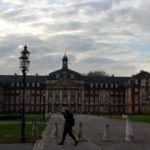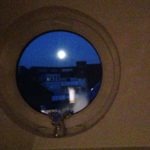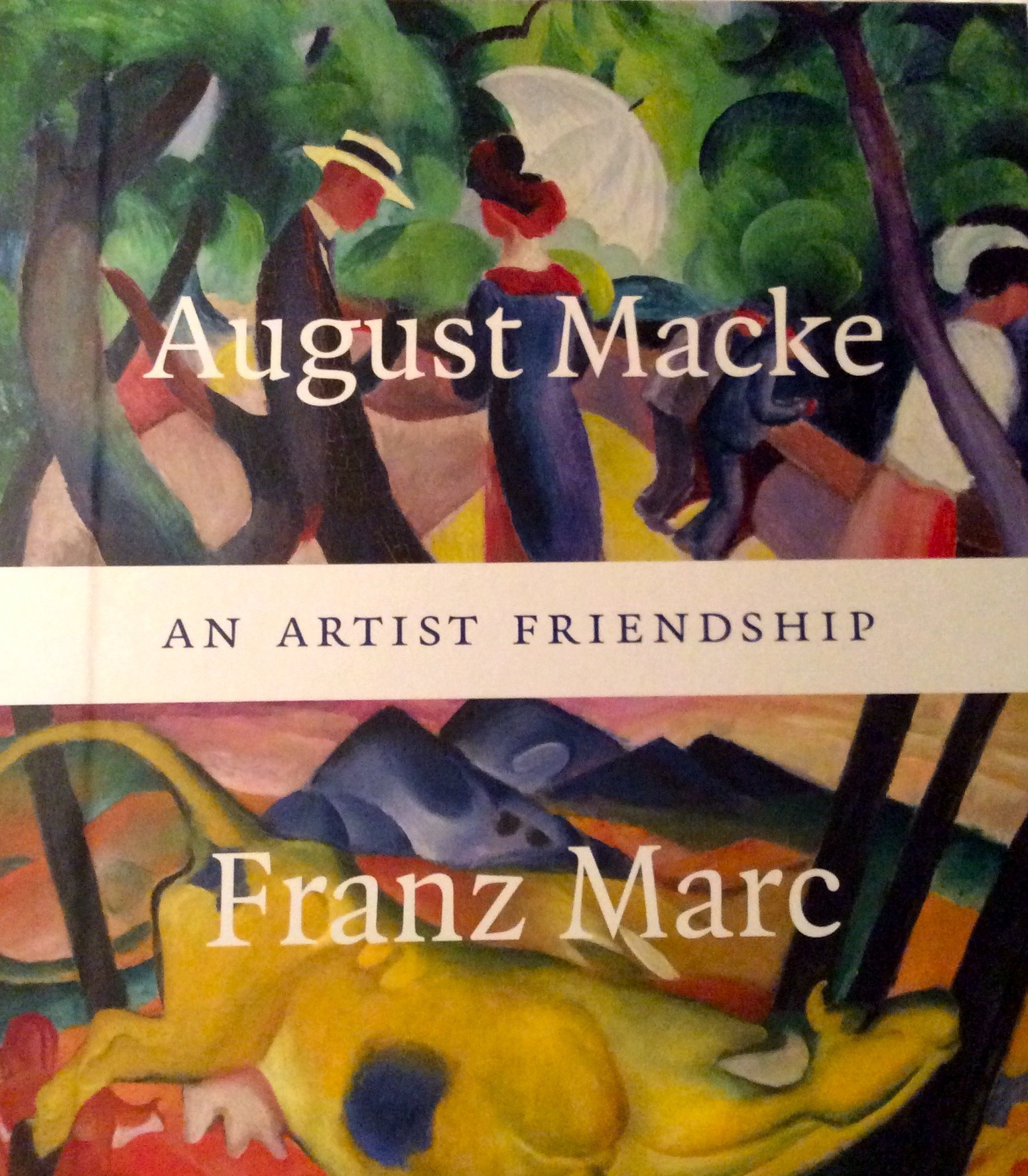
by Jean Marie Carey | 20 Jan 2017 | Art History, August Macke, Expressionismus, Franz Marc, German Expressionism / Modernism, Helmuth Macke
Book Review: August Macke and Franz Marc: An Artist Friendship
Catalog of an exhibition held at the Kunstmuseum Bonn, 25 September 2014 – 4 January 2015; and at the Städtische Galerie im Lenbachhaus und Kunstbau, Munich, 28 January – 3 May 2015; 359 pages with many color illustrations and black and white archival photographs.
I recently began doing some book reviews for Museum Bookstore, an online repository of catalogues and other printed material generated on behalf of museum and gallery exhibitions. My first review is of my favorite book of 2014-2015, the outstanding catalogue presented by the Lenbachhaus and Kunstmuseum Bonn in support of August Macke und Franz Marc: eine Künstlerfreundschaft. Please support this very worthy independent bookstore effort by checking out the companion text on the site.
§ § §
Published on 26 September 1914 to coincide with the 100th anniversary of the death of August Macke as well as the launch of the ambitious cooperative retrospective of Macke’s and Franz Marc’s overlapping oeuvres, the exhibition catalogue August Macke and Franz Marc: An Artist Friendship (August Macke und Franz Marc: eine Künstlerfreundschaft is its twin in the original German from which the English version has been translated) is, perhaps not surprisingly, a tour-de-force of editing and research. What is unexpected is that the editors, longtime Lenbachhaus Blaue Reiter curator Annegret Hoberg and Volker Adolphs of Kunstmuseum Bonn, along with a smartly-assembled team of university- and museum-based German art historians, bring to bear not just a wealth of knowledge but so much compassion to these essays, confronting directly the loss and sadness we naturally feel over the too-short lives of Marc and Macke. Macke, the extroverted Rhinelander, was killed in Champagne, France, at 27, while Marc, the contemplative Bavarian, died aged 36 at Verdun in the spring of 1916.
 Despite their frank sentimentality, the catalogue’s chapters and essays are impeccably scholarly. Hoberg’s “August Macke and Franz Marc / Ideas for a Renewal of Painting” and Adolphs’ “Seeing the World and Seeing Through the World / Nature in the Work of August Macke and Franz Marc” are classic art historiography based in peerless analysis. Hoberg focuses on the milieu of the international avant-garde that encouraged Marc and Macke to not only follow the careers of but become personally acquainted with the Parisian Orphist Robert Delaunay and the Italian Futurist Umberto Boccioni. While Marc’s primary subjects directly encompass animals and the pastoral, albeit reframed through a unique pantheistic realism, Macke, who often painted urban scenes, has a less direct relationship to “nature,” which Adolphs teases out, particularly in comparison to Marc.
Despite their frank sentimentality, the catalogue’s chapters and essays are impeccably scholarly. Hoberg’s “August Macke and Franz Marc / Ideas for a Renewal of Painting” and Adolphs’ “Seeing the World and Seeing Through the World / Nature in the Work of August Macke and Franz Marc” are classic art historiography based in peerless analysis. Hoberg focuses on the milieu of the international avant-garde that encouraged Marc and Macke to not only follow the careers of but become personally acquainted with the Parisian Orphist Robert Delaunay and the Italian Futurist Umberto Boccioni. While Marc’s primary subjects directly encompass animals and the pastoral, albeit reframed through a unique pantheistic realism, Macke, who often painted urban scenes, has a less direct relationship to “nature,” which Adolphs teases out, particularly in comparison to Marc.
(more…)

by Jean Marie Carey | 7 Jan 2017 | Art History, August Macke, Expressionismus, Franz Marc, German Expressionism / Modernism
 Whatever happens in the future, my time in Münster will be the happiest I can ever remember. I was there for several weeks and finally had a substantial Paradies mural Franz Marc and August Macke made together in Macke’s upstairs atelier in Bonn in 1912.
Whatever happens in the future, my time in Münster will be the happiest I can ever remember. I was there for several weeks and finally had a substantial Paradies mural Franz Marc and August Macke made together in Macke’s upstairs atelier in Bonn in 1912.
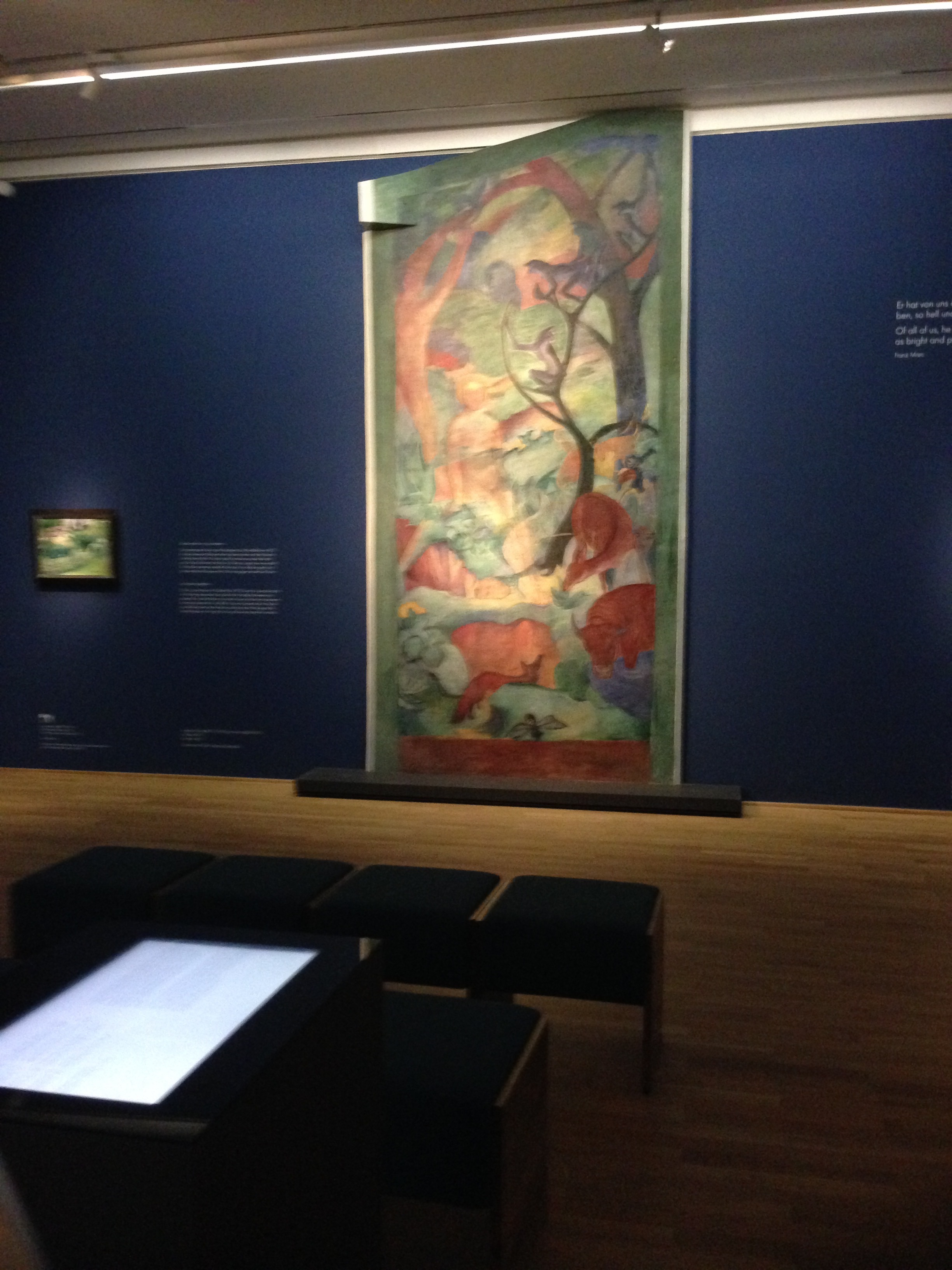
The mural was moved to Münster’s LWL-Museum für Kunst und Kultur in 1984. In a quiet room away from the museum’s main traffic areas, the mural is now the altar of a shrine to Macke and his relationship with his wife Elizabeth but also with Marc, phrases from his many letters to August decorating the blue walls.
The Hanseatic light of the west is stunning and soothing, like a house you’ve lived in your entire life – something almost no one does anymore that seems like a real memory.

by Jean Marie Carey | 28 Jul 2016 | Animals, Animals in Art, Art History, Franz Marc

Franz Marc’s mysterious nude in a landscape from around 1911.
In clear contrast to the well-planned execution of the grazing horses on its front, the verso of Weidende Pferde IV is wild, mysterious, and haunting, and provides an intimate look at Franz Marc’s more intuitive approach to color and form.
Though the composition is partially obscured, the underlying motifs are clear enough.
Shown is a reclining female nude in a dimly lighted landscape under a deep blue sky. The figure rests on her back, her right leg is bent. Her head with long and flowing red hair is slightly tilted to the right; her arms clasped behind her. This figure is somewhat characteristic for Marc in terms of the visible hatching and decorated, colorful outlines. The left of the picture area seems to indicate another figure whose gender and position we can only guess at. The middle of the picture consists of a dramatic, deeply-hued landscape, which in turn is what the reclining nude in the foreground would be part of and also looking at. Though Marc often painted nude figures relaxing outside, this painting does not seem to correspond to another finished work.

Weidende Pferde IV, 1911
Weidende Pferde IV is also a stunning picture when considered in terms of Marc’s efforts to produce it: Three red horses with purple mane prance against a lemon-yellow sky and a deep blue rock formation. Marc had devoted a lot of time to developing the arrangement of the horses’ bodies in this formation. Marc had been preoccupied, and had made a difficult and lengthy process of, how exactly to balance the shapes and colors of the horses in the overall composition.
Weidende Pferde IV is the star of the second part of the exhibition trilogy “Franz Marc: Zwischen Utopie und Apokalypse,” presented by the Franz Marc Museum in Kochel on the 100th anniversary of the death year of the painter. This is one of just a few paintings that Marc saw hung in a museum himself, following its creation in 1911 and first display at the Thannhauser’s Galerie Moderne in Munich
The same year the collector Karl Ernst Osthaus purchased Weidende Pferde IV for the Folkwang Museum’s first incarnation in Hagen. The painting sold for 750 marks, as Marc triumphantly informed his brother Paul on 3 December 1911.
Marc had been constantly busy with live horses during his years in Kochel and Sindelsdorf (“Pferde auf Bergeshöh gegen die Luft stehend”), and he studied them in detail as he drew, printed and painted them.
-

-
Franz Marc, c. 1909
-

-
Franz Marc, c. 1910
-

-
Franz Marc, c. 1910
The day before Alexej Jawlensky, Marianne von Werefkin and Adolf Erbslöh first visited Marc in Sindelsdorf on 3 February 1911, he wrote to Maria Marc who had at this time had left Bavaria to stay with her parents in Berlin, “Ich habe noch ein großes Bild mit 3 Pferden in der Landschaft, ganz farbig von einer Ecke zur anderen, angefangen, die Pferde im Dreieck aufgestellt. Die Farben sind schwer zu beschreiben. Im Terrain reiner Zinnober neben reinem Kadmium und Kobaltblau, tiefem Grün und Karminrot, die Pferde gelbbraun bis violett.”
The visitors loved the paintings, and by the day of his 31st birthday on 8 February Marc was a co-chairman of Neue Künstlervereinigung München.
Certainly the powerful painting of the reclining redhead should be regarded as an entirely discrete creation and given a proper name and place in the artist’s catalogue raisonné. It is curious that Harvard University’s Busch-Reisinger Museum, which purchased the painting when it was declared Entartete Kunst in 1937, has not taken the initiative to see that this is done. If only this painting could be permanently repatriated to Kochel, where it belongs.
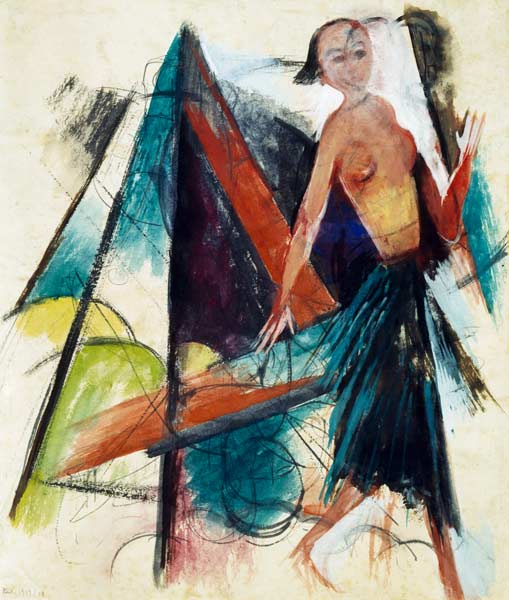
by Jean Marie Carey | 24 Nov 2015 | Art History, Expressionismus, Franz Marc, German Expressionism / Modernism, Re-Enactments© and MashUps

Miranda, 1914
So I am pleased and grateful to report the publication of my first peer-reviewed anthology chapter in the journal Expressionismus in the special issue Der performative Expressionismus. The article is called “‘Der Sturm’ und die Wilden.? Franz Marcs Entscheidungskampf mit der Theatralität,” which translates imperfectly to something like “‘The Tempest’ and the Savages: Franz Marc’s Decisive Encounter with Theatricality.” (Entscheidungskampf can also mean something like Armageddon/scorched earth, which in this case is accurate.)
The article is currently behind the Neofelis Verlag paywall (for a very reasonable €13), but you will soon find it on JSTOR and elsewhere. If you have any questions about how to view article please email me.
This side project to my main research corrects some chronological errors that have consistently been repeated in both Expressionist and Dada literature about the collaboration of Franz Marc and Hugo Ball on a planned production of The Tempest at the Münchner Kammerspiele. Because the story takes place in early 1914, it has been tempting for scholars – some of them quite formidable – to conclude that it was the war that usurped these plans. However, that is not at all the case.
“What really happened” is of course quite interesting on its face and as a reminder that we in fact know very little in the way of actual facts about the historical avant-gardes, who are fast disappearing into hagiography.
More interesting to me, in terms of writing and research, was the analysis of the two small drawings Marc made as character studies of The Tempest’s Miranda and Caliban personalities. This is the first time these drawings, housed in the Kunsthalle Basel, have been subjected to such scholarly scrutiny and each contains many clues and psychological implications.
I was also intrigued to discover that Marc had sent a draft of his June 1914 essay »Das abstrakte Theater,« (also analyzed in the article) about his frustrating foray into the theater to August Macke, and that the two had previously had many exchanges about the performing arts. In fact it is clear that the very precocious Macke – who at only 21 had been the chief set designer for the theater in Düsseldorf – had had a great influence on Marc’s ideas on the subject – ideas being the key word, since Marc had no firsthand dramaturgical knowledge up until this point.
My colleague here at the university, Prof. Dr. August Obermayer, was the very gracious translator but he also provided invaluable editing and advising, and the Neofelis editors were also a pleasure to learn from.
All in all a great experience and I hope readers will find the unraveling of Expressionist mysteries as fascinating as I do.

Caliban, 1914
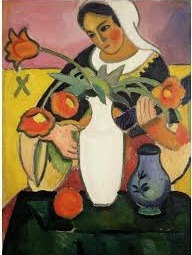
by Jean Marie Carey | 5 Mar 2015 | August Macke, Expressionismus, Franz Marc, German Expressionism / Modernism, Re-Enactments© and MashUps

Die Lautenspielerin, August Macke, 1910
“Recent publications” is in quotes because all of the great opportunities to preach the gospel of Marc lately have come to me strictly through the generosity of other people, so I will quickly get to the point of thanking Trang Vu Thuy and the curatorial staff at the Lenbachhaus and Janine Arnold of Notes About Art. (Please click through the links to view the articles themselves.)
My post (which is present entirely owing to the patience of Vu Thuy) “Ein Manifest der Freundschaft” is in honor of the August Macke und Franz Marc: Eine Künstlerfreundschaft exhibition (on through 3 May 2015 in the Lenbachhaus Kunstbau) and concerns one of my favorite subjects, the Paradies mural.
“Von »Köstlichen Figürchen« und »Wunderherlichen Farben«” by assistant curator Monika Bayer-Wermuth is actually the most wonderful post, though, on the gifts sent by the Marcs to the Mackes and is told in the same thoughtful, personal vein as are many of the chapters in the companion catalogue.
Thanks to the generous invitation of Arnold, I have two entries on her Notes About Art website, one called “Confrontations & Reconciliations” about my interpretation of Franz Marc’s gift of the painting Blaues Pferdchen, Kinderbild to August Macke and the other a bit about the history of Marc’s two Turm der blauen Pferde.
I am very happy to see art historians collaborating across distance and language just because we like the art and want for other people to be able to know about and appreciate the work of Der Blaue Reiter. (more…)

 Despite their frank sentimentality, the catalogue’s chapters and essays are impeccably scholarly. Hoberg’s “August Macke and Franz Marc / Ideas for a Renewal of Painting” and Adolphs’ “Seeing the World and Seeing Through the World / Nature in the Work of August Macke and Franz Marc” are classic art historiography based in peerless analysis. Hoberg focuses on the milieu of the international avant-garde that encouraged Marc and Macke to not only follow the careers of but become personally acquainted with the Parisian Orphist Robert Delaunay and the Italian Futurist Umberto Boccioni. While Marc’s primary subjects directly encompass animals and the pastoral, albeit reframed through a unique pantheistic realism, Macke, who often painted urban scenes, has a less direct relationship to “nature,” which Adolphs teases out, particularly in comparison to Marc.
Despite their frank sentimentality, the catalogue’s chapters and essays are impeccably scholarly. Hoberg’s “August Macke and Franz Marc / Ideas for a Renewal of Painting” and Adolphs’ “Seeing the World and Seeing Through the World / Nature in the Work of August Macke and Franz Marc” are classic art historiography based in peerless analysis. Hoberg focuses on the milieu of the international avant-garde that encouraged Marc and Macke to not only follow the careers of but become personally acquainted with the Parisian Orphist Robert Delaunay and the Italian Futurist Umberto Boccioni. While Marc’s primary subjects directly encompass animals and the pastoral, albeit reframed through a unique pantheistic realism, Macke, who often painted urban scenes, has a less direct relationship to “nature,” which Adolphs teases out, particularly in comparison to Marc.






